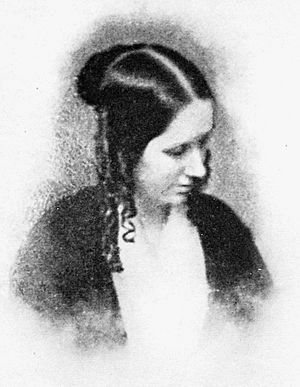Elizabeth Cabot Agassiz facts for kids
Quick facts for kids
Elizabeth Cabot Agassiz
|
|
|---|---|
 |
|
| 1st President of Radcliffe College | |
| In office 1882–1903 |
|
| Succeeded by | LeBaron Russell Briggs |
| Personal details | |
| Born |
Elizabeth Cabot Cary
December 5, 1822 Boston, Massachusetts, U.S. |
| Died | June 27, 1907 (aged 84) Arlington, Massachusetts, U.S. |
| Spouse | |
Elizabeth Cabot Cary Agassiz (born December 5, 1822 – died June 27, 1907) was an amazing American educator, a person who studied nature (a naturalist), and a writer. She helped start and became the first president of Radcliffe College. Elizabeth Agassiz loved to research and write about natural history. She wrote and drew pictures for her own books. She also worked with her husband, Louis Agassiz, and her stepson, Alexander Agassiz, on their natural history books.
Elizabeth joined her husband on his trips to Brazil (1865-1866) and on the Hassler expedition (1871-1872). She wrote about the second trip for a magazine called Atlantic Monthly. She also published her own book, A First Lesson in Natural History, in 1859.
Contents
Early Life and Learning
Elizabeth Cabot Cary was born on December 5, 1822, in Boston, Massachusetts. Her family was well-known in New England. She was the second of seven children. Her family and friends called her "Lizzie."
Because she was often sick, Elizabeth was taught at home. She learned languages, drawing, music, and reading. She also got informal history lessons from a special teacher, Elizabeth Peabody.
Elizabeth Agassiz's Career
Elizabeth traveled with her husband and family. They went to Charleston, South Carolina, for his teaching job in the winters of 1851-1852 and 1852-1853. She also visited Europe with him in 1859. She worked closely with her husband on his science projects.
She was the main writer and record keeper for two big trips. The first was the Thayer Expedition to Brazil, from April 1865 to August 1866. The second was the Hassler Expedition through the Strait of Magellan, from December 1871 to August 1872.
In 1856, Elizabeth started a school for girls in her home in Cambridge. Her husband helped by teaching classes. Other professors from Harvard also came to teach. After her school closed in 1863, she helped plan and manage the Thayer Expedition to Brazil. This trip happened right after the American Civil War ended.
In 1867, she started writing letters to Arnold Henry Guyot, a scientist who studied rocks (geologist) and weather (meteorologist). She also helped organize the Hassler Expedition. This was an important U.S. government trip to explore the ocean. She wrote down many notes from this journey. After her husband passed away in 1873, she published several books about nature. She had worked on these books for many years.
Elizabeth Agassiz also helped create the Anderson School of Natural History. This school allowed both boys and girls to learn. In 1869, she became one of the first women to join the American Philosophical Society. This was a big honor!
Founding Radcliffe College
In 1879, Elizabeth was one of seven women who led a group called the Society for the Private Collegiate Instruction for Women. This group helped women who wanted to study at Harvard College. They arranged for Harvard professors to teach these women privately.
Elizabeth Agassiz was very important in changing this "Harvard Annex" into Radcliffe College in 1894. This college was specifically for women. She led the college from 1894 to 1900. From 1900 to 1903, she was the honorary president. She was very good at talking to people and raising money. Her efforts helped the college continue to grow and succeed.
Elizabeth also joined a committee that helped a kindergarten for blind children. She was the treasurer for the Cambridge part of this committee until she became ill in 1904.
Research and Published Books
You can learn about Elizabeth's research through her books and her travel diaries. Her books include A First Lesson in Natural History (1859) and Seaside Studies in Natural History (1865). Her stepson, Alexander Emanuel Agassiz, helped her with Seaside Studies.
Elizabeth first published A First Lesson using a secret name, Actaea. She also wrote A Journey in Brazil (1868) with her husband. In 1885, she edited and published Louis Agassiz: His Life and Correspondence. Later, her sister and another writer wrote a biography about Elizabeth Agassiz.
Personal Life
Elizabeth met the scientist Louis Agassiz in 1846. They wanted to get married, but he had a wife and three children in Switzerland. After his wife passed away in 1848, Elizabeth and Louis married on April 25, 1850, in Boston.
Elizabeth took care of their home and money. She also cared for Louis's children, Alexander, Ida, and Pauline. She became very close to her stepchildren and her grandchildren. Elizabeth did not have any children of her own.
After her husband died in 1873, she kept working and spending time with her family. She still loved to travel. In 1892, Elizabeth went with her family to the Pacific Coast in California for three months.
Elizabeth Agassiz passed away on June 27, 1907, in Arlington, Massachusetts. She is buried with her husband in Mount Auburn Cemetery. Their gravestone is a large rock from a glacier near where Louis Agassiz once lived.
Selected Works
- A First Lesson in Natural History (1859)
- Seaside Studies in Natural History (1865)
- A Journey in Brazil (1868)
- Louis Agassiz: His Life and Correspondence, vol. I and vol. II (1885)
See also
 In Spanish: Elizabeth Cabot Agassiz para niños
In Spanish: Elizabeth Cabot Agassiz para niños


